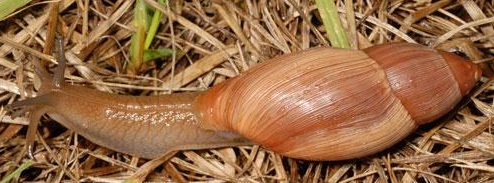Euglandina rosea
Rosy Wolfsnail
Class: Gastropoda
Order: Stylommatophora
Family: Spiraxidae

Photographer: Lyle J. Buss, UF/IFAS
Source: http://entnemdept.ufl.edu/creatures/misc/gastro/slugs_of_florida05.htm
Description
The rosy wolfsnail has a light brown elongated shell and a light grey or brown body. Its lower tentacles are long and almost touch the ground. The shell is often 40 to 50 mm in maximum dimension but can sometimes be as large as 60 or even 70 mm. The immature snails have a shorter shell and can be almost appear yellow in color.
Ecological Threat: Predatory snails such as the rosy wolf snail, Euglandina rosea, will attack slugs, and may account, in part, for the relatively low slug densities in Florida and other states. Euglandina rosea prefers snails to slugs, but will attack and consume small slugs in the absence of snail prey. Smaller prey species can even be digested whole given the rosy wolfsnail the nickname “the cannibal snail”. Due to its voracious and predaceous appetite the rosy wolfsnail is a fierce invasive gastropod that can severely threaten native gastropods. For Hawaii it is thought that the rosy wolfsnail is responsible for causing the extinction of 1/3 of the native gastropods.
Biology: Euglandina rosea is a cross-fertilizing hermaphroditic. This means that even though each individual snail is both male and female they require a “partner” for fertilization. Rosy wolfsnail can lay approximately 25 - 40 eggs a year. The eggs hatch after 30 days and the individuals that emerge can live up to 2 years.
History: Euglandina rosea is native to some southeastern United States (except Texas), and is quite common in woodlands and gardens in Florida. It has been relocated to other parts of the world, including Hawaii (in 1955), in an attempt to control invasive snails such as giant African land snail, Achatina fulica. It has been used to provide partial control of giant African snail, but it had a preference for native snail populations, so its use is discouraged outside its natural range.
U.S. Habitat: Euglandina rosea can be found in hardwood forests, roadsides and urban gardens.
Distribution
Native Origin: Tropical North America and AL, FL, GA, LA, MS, NC and SC
U.S. Present (invasive): CA, HI and TX
Management
According to the Global Invasive Species Database (issg.org), Euglandina rosea is considered one of the world's 100 worst invaders. The presence of Euglandina rosea has been strongly linked to the extinction and decline of numerous snail species in every area where it has been introduced. Conservationists are working to prevent the further spread of Euglandina rosea. “Exclosures” have been built in Hawaii and French Polynesia to prevent E. rosea from attacking native tree snails. These barriers are somewhat successful but require constant monitoring and maintenance. A toxic bait using snails from the genus Pomacea is being tested in Hawaii.
References
Barker G.M. 2004. Natural Enemies of Terrestrial Molluscs. CABI Publishing, Wallingford, UK. 644
Internet References
http://eol.org/pages/452700/overview
http://www.issg.org/database/species/ecology.asp?si=92&fr=1&sts=
http://www.columbia.edu/itc/cerc/danoff-burg/invasion_bio/inv_spp_summ/Euglandina_rosea.html
http://www.manandmollusc.net/Odessa/rosy.html
 Texas Invasive Species Institute
Texas Invasive Species Institute